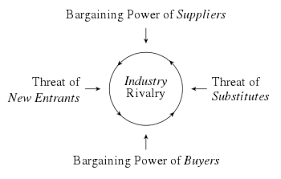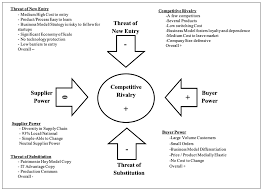Porter's Five Forces - Explained
What is Porter's Five Forces?
- Marketing, Advertising, Sales & PR
- Accounting, Taxation, and Reporting
- Professionalism & Career Development
-
Law, Transactions, & Risk Management
Government, Legal System, Administrative Law, & Constitutional Law Legal Disputes - Civil & Criminal Law Agency Law HR, Employment, Labor, & Discrimination Business Entities, Corporate Governance & Ownership Business Transactions, Antitrust, & Securities Law Real Estate, Personal, & Intellectual Property Commercial Law: Contract, Payments, Security Interests, & Bankruptcy Consumer Protection Insurance & Risk Management Immigration Law Environmental Protection Law Inheritance, Estates, and Trusts
- Business Management & Operations
- Economics, Finance, & Analytics
Understanding Your Business Position in the Industry
The previous discussion analyzes the business and the overarching environment affecting the business. Now we turn our sights to understanding our business place in the industry. The most common and well-known tool for examining the business situation is Porters Five Forces (PFF), again introduced by Harvard Business Professor Michael Porter. The overall purpose of the PFF analysis is to allow you to use your knowledge to strengthen your position in the market. Particularly, it is useful in determining whether a new strategy, product, or business model will be successful in the relevant market.
What is Porters Five Forces?
PFF breaks down a given business position into five distinct forces. The forces are as follows:
- Supplier Power
- Buyer Power
- Competitive Rivalry
- Threat of Substitution
- Threat of New Entry
Breaking Down the Forces
The PFF analysis demonstrates the market power of the business with regard to this business force. The following diagram displays the interrelation of the forces.
Here is a brief overview of each force.

Supplier Power
Supplier power addresses the relative strength of suppliers in the industry. A supplier with more power has a greater ability to bargain for and capture value in the exchange of value between them and the customer (your business). That is, the higher the supplier power the more control they have over prices (ability to drive up costs). If your business is not capable of passing the costs along to customers, then it lowers your profit margin and your competitive position in the market. Dont think of the supplier analysis as examining a single supplier; rather, it involves the entire group of suppliers in the market. Supplier power is generally a product of the number of factors, including:
- The number of suppliers in the market.
- Note: If the suppliers are more concentrated on the customer market(businesses) then the buyer has greater power. o The value proposition of any suppliers goods.
- Note: Certain suppliers may have a differentiated product with a higher value proposition)
- Competitive advantage to any individual suppliers.
- Note: Certain suppliers have competitive advantages that allow them to monopolize larger shares of a given market. Examples of competitive advantage include, intellectual property rights, lower cost structures, geographical location, established infrastructure, etc.)
- Lack of substitute products on the market.
- Note: A lack of substitute products on the market gives a group of suppliers increased power. If this lack of substitutes is combined with a competitive advantage among individual suppliers, then the supplier power is very high.
- The Cost of switching to a different supplier.
- Note: If switching costs are high, suppliers have much greater power in the short-run. If the customer business is able to establish a long-term relationship with a new supplier, then the impact of the switching costs are less and the supplier power is lessened.
- Diversification of the Suppliers.
- Note: If the suppliers have multiple revenue sources in the industry, then it is diversified in its customer base. Since the suppliers do not depend strictly on the revenue from supplying you or business like you in the industry, then the supplier has greater power.
- Threat of Supplier Integration.
- Note: Does the supplier have the ability and desire to become a competitor? If a supplier decided to join with a competitor or begin competing in the market, then they have greater supplier power. If the customer business tries to exercise too much power over the supplier, then the supplier will simply forgo supplying to the customer and enter the market as a competitor. This is known as integrating forward in the business.
Buyer Power
Buyer power regards the ability of customers to control product prices in your market. The more power customer is able to grab more value in an exchange by either driving up costs or demanding higher levels of service or quality of product. Buyer power is important for both B2B (business-to-business) and B2C (business-to-customer) businesses. Here are some situations in which buyers possess greater power to control prices:
- Number of Buyers
- Important Individual Customers
- Low Cost of Switching
- Note: If the cost of changing to another product or service provider is low, then the buyer has leverage to bargain for more value. This option concerns the presence of competitors or the availability of substitute products in the market. Buyers are often able to make competitors compete for their business by offering lower prices or greater benefits.
- Price Sensitivity of the Buyer
- Note: This factor concerns more the preference of the buyer, rather than ability. A more price-sensitive buyer will have a greater incentive to demand more value in the transaction. A less price-sensitive buyer will be concerned less with price than other factors, such as quality of service, the difficulty of switching, etc.
What is Competitive Rivalry?
Competitive rivalry concerns the ability of your competitors to increase their market share. If you have numerous competitors or any competitors with superior value propositions (lower price, higher quality product, etc.) then your competitors have strong market power. Below are some common scenarios where competitors have high levels of market power:
- A Large Number of Competitors in the Market
- Note: A large number of competitors in the market allows consumer many options. Through the availability of consumer options, these competitors can affect sales. Further, a large number of competitors generally increases supply. Remember basic economics, an increase in supply means lower prices at the corresponding level of demand.
- Competition Through Price
- Note: Price wars between competitors (a tactic to gain market share) shifts value to the buyer as prices lower. This is most common when: all products are relatively similar, the industry has low marginal costs, or the products are perishable or part of a weakening trend.
- Competition through Differentiation
- Note: Competitors in the market may attempt to gain market share via product differentiation. This includes any feature that is more attractive (higher value proposition) to customers than your product feature. Examples would include higher quality, convenience, ease of use, a unique feature, customer service, etc. The benefit of this type of competition is that it often raises the barrier of entry to potential new competitors.
What are Threat of Substitutes?
The threat of substitutes or substitution regards the ability of other (non-industry) products or services to meet the wants or needs of your customer base. It also concerns the ability and motivation of customers to figure out a way to fulfill the need or want without your product or service. If this is possible, then it weakens your business market power by placing limits on the prices of your product or service.
- Note: The very existence of substitute products may be difficult to identify. Identifying customer substitutes is an indication in itself that your business may have lost market power. The presence of substitutes becomes most critical when switching costs are low.
What is the Threat of New Entry?
This concerns the ability of new competitors to enter the market. As we discussed above, new competitors increase competition and ultimately push down prices. Further, new competitors will occupy some portion of the market, which may diminish your business existing market share. So, the ability of new competitors to enter the market easily indicates lower market power.
- Note: Competitors are generally able to enter into the market when barriers to entry are low (such as the capital costs of entering the market). Other barriers to entry include: brand loyalty of customers; there are few switching costs, there are no intellectual property protection in the business (i.e., trade secrets or patents), open distribution channels, strong capital base; low regulatory or licensing requirements, or the business does not benefit from economies of scale. If none of these barriers exist, then a business must employ a strategic reaction to new entrants that will put pressure on the entrant and discourage new entrants.
Summary Model of Porter's Five Forces

Related Topics
- How Strategies Arise
- Intended, Deliberate, Realized, and Emergent Strategies
- Management and Strategic Planning
- Mintzberg's Schools of Strategic Development
- Design School
- Planning School
- Positioning School
- Entrepreneurial School
- Cognitive School
- Learning School
- Power School
- Culture School
- Environmental School
- Configuration School
- Mintzberg's 5Ps of Strategy
- McKinseys 7s Model
- ***Industry Analysis to Build a Strategy***
- Strategic Analysis
- SWOT Analysis
- SPACE Analysis
- Situational Analysis - 7C
- Competition Profile Matrix
- Stakeholder Analysis
- Stakeholder Mapping
- Resources and Capabilities
- VMOST
- Core Competency
- VRIO Analysis
- Value Chain Analysis
- Internal Factor Analysis
- Value Creation Index
- Minimum Efficient Scale
- PEST(LE) Analysis
- Industry Lifecycle Analysis
- Company Lifecycle - Definition
- Porter's Five Forces
- Modes of Management
- External Factor Evaluation
- Business Performance Measurement
- Benchmarking
- Balanced Scorecard
- Economic Value Added
- Activity-Based Management
- Quality Management
- Action Profit Linkage Model
- Business Activity Monitoring
- Gap Analysis
- Strategy Diamond
- BCG Growth-Share Matrix
- GE McKinsey Matrix
- Value Reporting Framework
- Pyrrhic Victory